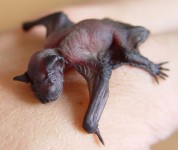By Creation Moments When a young man prepares himself to meet his young lady, he slaps on a little cologne, hoping to please her. It turns out that the males of at least some species of bats do the same thing. Researchers have recently discovered how a small North American tropical bat prepares to attract and keep his harem of up to eight females. In late afternoon the bat begins a ritual that takes more than half an hour to complete. read more …read more Read more here: Creation Moments
By Creation Moments One of the common methods of finding the age of rocks, and ultimately the age of the Earth, measures the decay of radioactive uranium into lead – the more lead, the older the rock. The method, however, makes some very big assumptions. First, scientists assume there was no lead in the rock when it first formed, but this is unprovable. Then, they assume that rocks are like locked vaults and that no uranium, lead, or the in between decay elements can ever enter or leave the rock. read more …read more Read more here: Creation Moments
By Creation Moments The blessings of modern medicine have saved many lives. Unfortunately, modern medicine’s accomplishments have led many people to believe that good medical treatment is more important than God’s healing power when you are sick. Astounding medical discoveries are being made all the time. For example, 60 percent of those with diabetes suffer nerve damage. This nerve damage can result in the body’s inability to control blood pressure as well as other problems. In some diabetics, branching nerve cells swell, cutting off normal cell communication. read more …read more Read more here: Creation Moments
By Creation Moments Whales pose some interesting problems for those who believe that all living things slowly evolved to their present forms over millions of years. According to evolution, sea creatures gradually adapted to life on land because they could make a better living there. That’s where mammals supposedly evolved. Then, for some unknown reason, some of those mammals – Darwin said it was the bear – decided to return to the sea. read more …read more Read more here: Creation Moments
By Creation Moments When you are a small animal whose diet could injure or even kill you, eating can be positively dangerous. That danger increases if you belong to a family of animals that normally takes minutes or even hours to swallow a victim. read more …read more Read more here: Creation Moments
By radio@answersingenesis.org (Steve Ham) …read more Read more here: Answers Conversation
By Multimedia Does a commitment to science mean the death of God? On this episode of ID the Future, hear from bestselling author Eric Metaxas about his new book “Miracles: What They Are, Why They Happen, and How They Can Change Your Life.” Metaxas discusses the scientific evidence that points towards, rather than away from, a creator, and addresses the straw man critiques of his popular WSJ article “Science Increasingly Makes the Case for God.” Your browser does not support playing Audio, please upgrade your browser or find our podcast on podOmatic Download Episode …read more Read more here: id [More]
By Creation Moments Modern psychologists and social engineers generally hold that children are born innocent. Any evil they do is learned from those around them. Based upon this notion, they advise that children should not be spanked because that spanking only teaches violence. This modern teaching contradicts the biblical teaching that we are born in original sin, inherited from Adam. Belief in original sin is accepted in some form by most Christians, Jews and practically everyone who has ever raised children! read more …read more Read more here: Creation Moments
By Creation Moments A strange and beautiful family of creatures known as ammonoids nicely illustrate the illogic and lack of scientific reasoning used by defenders of evolution. While the chambered nautilus is the only species of ammonoid that exists today, the fossil record reveals hundreds of extinct species. While some, like the chambered nautilus, had relatively simple shells, others had intricately detailed shells with ruffled, wavy walls. read more …read more Read more here: Creation Moments
By radio@answersingenesis.org (Steve Ham) …read more Read more here: Answers Conversation
By Creation Moments Flight is a big problem for those who believe that we owe our existence to evolution. Birds, mammals, reptiles, insects, and even some fish fly or at least glide through the air in controlled flight. So many different creatures fly that evolutionists must say that flight evolved several different times. The dragonfly is among the best fliers in the animal kingdom. read more …read more Read more here: Creation Moments
By Creation Moments We have always been told that it takes millions of years for muddy deposits to turn into rock. Those who believe in creation have always disagreed. It seems pretty clear to us that much of the sedimentary rock we see today was deposited during the Great Flood at the time of Noah, which was not millions of years ago. Creationists generally place the Flood at about 4,600 years ago. Until recently, evolutionists dismissed this date as impossible: sedimentary rocks simply could not form that fast. Well, now it seems that they spoke too soon. read more …read [More]
By Creation Moments We hear many warnings these days that tell us not to eat this food, it’s full of cholesterol, or that food, it’s loaded with fat. It’s easy to come to the conclusion that the curse of sin has turned the whole creation against us. But God is a merciful God. He has given us the ability to learn about many of the beneficial foods and medicines that He has created. read more …read more Read more here: Creation Moments
By Multimedia On this episode of ID the Future, Casey Luskin finishes his interview with Dr. Wolf-Ekkehard Lönnig, an expert in plant breeding formerly affiliated with the Max Planck Institute for Plant Breeding Research in Germany. Dr. Lönnig discusses how Darwinian evolutionary biology held back the acceptance of the laws of inheritance, discovered by the famous monk Gregor Mendel. Your browser does not support playing Audio, please upgrade your browser or find our podcast on podOmatic Download Episode …read more Read more here: id the future
By Multimedia On this episode of ID the Future, Casey Luskin continues talking with geneticist Wolf-Ekkehard Lönnig about Gregor Mendel’s laws of inheritance and how they opposed the thinking of Darwin. Lönnig explains how Darwinian evolution hindered the acceptance of Mendel’s genetic laws, and how the laws still came to be accepted. Your browser does not support playing Audio, please upgrade your browser or find our podcast on podOmatic Download Episode …read more Read more here: id the future
By Multimedia On this episode of ID the Future, geneticist Wolf-Ekkehard Lönnig talks with CSC Research Coordinator Casey Luskin about Gregor Mendel’s laws of inheritance and how they opposed the thinking of Darwin. Listen in as Dr. Lönnig explains Mendel’s laws and why they’re still relevant for biology, and particularly genetics. Your browser does not support playing Audio, please upgrade your browser or find our podcast on podOmatic Download Episode …read more Read more here: id the future
By Creation Moments Most Christians realize that going to church, and worshiping in earnest, keeps them spiritually healthier. A study by Duke University researchers backs up an earlier study that people who attend church at least once a week do have better health and live longer lives. read more …read more Read more here: Creation Moments
By Creation Moments Why do 60 seconds make a minute? Why does an hour have 60 minutes? After all, there are no natural reasons for this. A year is a natural time measurement, based on the sun’s position in the sky. Well, believe it or not, there may be connection between the length of an hour and the golden statue built by King Nebuchadnezzar that Daniel and his friends refused to worship. read more …read more Read more here: Creation Moments
By Creation Moments The creation is literally filled with millions of what those who believe in evolution call “happy coincidences.” But when you encounter millions of instances of what appears to be thoughtful design, the obvious conclusion is that there is a Designer. Take the example of bird eggs. read more …read more Read more here: Creation Moments
By radio@answersingenesis.org (Steve Ham) …read more Read more here: Answers Conversation
By Creation Moments In August 1989, Voyager 2 made its contact with the planet Neptune nearly 3 billion miles from Earth. This was a tremendous technical achievement and enabled mankind to know a little more of the planetary system in which we all live. read more …read more Read more here: Creation Moments
By Creation Moments You may be aware that the common cuckoo does not feed or raise its own young. Instead, it lays its eggs in the nests of other birds. The adoptive parents feed and raise the young cuckoo as their own until the cuckoo gets larger than the foster parents and flies away without so much as a “thank you.” read more …read more Read more here: Creation Moments
By Multimedia On this episode of ID the Future, CSC Research Coordinator Casey Luskin discusses recent media coverage of the 2012 Sutter’s Mill meteorite that falsely reports it as containing “seeds of early life” which could have helped generate “[t]he primordial soup of the early Earth.” Tune in as Luskin reveals the weak science — and significant political motives — behind these claims, which one organic chemist describes as “at best misleading, at worst . . . down-right fraudulent.” Your browser does not support playing Audio, please upgrade your browser or find our podcast on podOmatic <a class="colorbox" …read more [More]
By Multimedia Which requires more faith? A belief in multiple universes or a belief in the intelligent design of our universe? On this episode of ID The Future, host David Boze explores the ideas found in a Harper’s Magazine article by MIT physicist and author Alan Lightman. Some physicists attempt to side-step the intelligent design implications of our finely-tuned universe by suggesting that ours is merely one of countless universes, each with its own laws and constants. Lightman: “If the multiverse idea is correct, then the historic mission of physics to explain all the properties of our …read more Read [More]
By Creation Moments Do you remember how much milk is in your refrigerator? Do you remember which leftovers you have in there, and where you put them? This kind of memory is called episodic memory. It allows you to travel back in time with your mind to remember the details of a past action. Until now, it was thought that only humans had this kind of memory, although some researchers were convinced that monkeys and rats had episodic memory. read more …read more Read more here: Creation Moments
By Creation Moments The consequences of man’s sin have touched every part of the creation. After God made us, He declared His entire creation “very good,” which by God’s standards is perfect. But human rebellion against God set at work the forces of death throughout the creation. The gnat like jewel wasp is a good example of this. Under the microscope the jewel wasp lives up to its name, showing patterns of iridescent colors that change with the light. But that’s about all there is about the jewel wasp that reflects its perfect creation. read more …read more Read more [More]
By Multimedia On this episode of ID the Future, David Boze talks with Casey Luskin about the Precambrian fossil Vernanimalcula, which was thought to be the proof that Darwinists needed to refute the idea of the Cambrian explosion–the idea that life exploded in complexity during a specific period of time. Vernanimalcula was thought to be the Precambrian ancestor of all bilaterian animals, dating back to tens of millions of years prior to the Cambrian explosion. However, a new article published in Evolution & Development has concluded that “There is no evidential basis for interpreting Vernanimalcula as an animal, let alone [More]
























